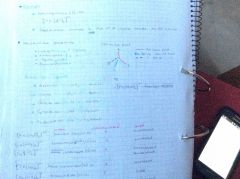![]()
![]()
![]()
Use LEFT and RIGHT arrow keys to navigate between flashcards;
Use UP and DOWN arrow keys to flip the card;
H to show hint;
A reads text to speech;
12 Cards in this Set
- Front
- Back
- 3rd side (hint)
|
Transition elements. Definition |
Elements that contain an incomplete d level of electrons in one or more of its oxidation states Zn is not a transition element |
|
|
|
Multiple oxidation state |
Successive ionization Energy; no big difference between one IE and the next |
Reasons |
|
|
Complex ions |
•because of their high positive charge, t.m. ions attract species that are rich in electrons called ligands |
|
|
|
Ligands |

• neutral molecules or negative ions that contain a non-bonding pair of electrons, which can form dative (coordinate) covalent bonds with the t.m. ions to form complex ions
• amount: 2,4 or 6 • Coordination geometries *Linear (2) *tetrahedral (4) *square plane (4) *octahedral (6) |
Def |
|
|
Monodentate ligands |
•only give one pair of electrons •small molecules •example *Water *Ammonia (NH3) *Cl- * Cyanide (CN-) *hydroxide (OH-) |
Uses for EDTA |
|
|
Polydentate ligands |
•More than 1 pair of electrons •Big molecules •Ex: EDTA *surround t.m. Ions *removal of heavy metal *chelating therapy *water softening *Food preservation *restoring metal structures *cosmetics |
|
|
|
Colored compounds |
•Depend on: element, oxidation state & kind of ligand • when 6 ligands approach a t.m. ion to form a complex ion, the d orbitals are split into two sublevels (d-d split) •the higher the difference between energy levels, the higher the frequency of the wave absorbed •the bigger the gap, the more energy needed |
Def catalyst Reason |
|
|
Catalytic behavior |
•Catalyst: speed up the rate of a chemical reaction being chemically the same at the beginning and at the end of the reaction • because of multiple oxidation state |
Phase Mode of action |
|
|
Catalytic behavior; homogenous |
•= phase as reactants •Mode of action: change in oxidation state in the middle of the reaction •intermediate products: appear 1st reaction, disappear 2nd |
Phase MoA |
|
|
Catalytic behavior; heterogenous |
•different phase as the reactants •generally solids. ^surface area where reaction takes place •Mode of action: reactants adsorpted (stick to surface). React in active sites (bond w/ right orientation) |
uses |
|
|
Catalytic behavior: heterogeneous |
* catalytic converter (rhodium or platinum *decomposition of hydrogen peroxide (MgO2) *Contact process (V2O5) *Haber process (Fe) *conversion alkenes-alkanes (Ni) |
3 types |
|
|
Magnetic properties |
•Diamagnetism *weak opposition to magnetic field *in most objects •Paramagnetism *substances with unpaired e- *magnetization proportional to applied field •Ferromagnetism *magnetized in order of great magnitude * Fe, Ni, Co |
|

